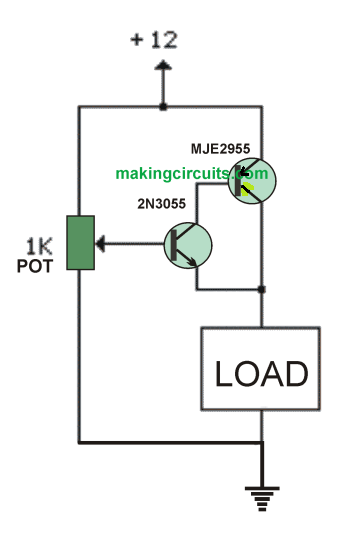This simplest variable 0-100V power supply circuit will allow the user to get a seamlessly adjustable output voltage, which could e fixed at any desired level. The power supply ca handle as high as 10 amps which looks adequate for most electronic circuit requirement.
A straightforward yet an effective technique of controlling a DC voltage can be to employ a voltage divider and transistor emitter follower arrangement. The image down the page shows applying a 1K pot to create the base voltage of any suitable power NPN transistor.
The collector of the NPN operates the base of a more substantial PNP power transistor that resources the required amount of current to the connected load.
The output voltage is going to be around 0.7 volts under the voltage at the slider arm of the 1K pot therefore the output can easily become variable from 0 to the full supply voltage (100V) subtracting 0.7 volts.
Applying a couple of transistors offers a good current gain of approximately 1000 or maybe more to ensure that solely a few milliamps of current is actually consumed through the voltage divider to provide a few amps of current at the output.
Remember that this circuit is not too efficient compared to a switch mode type of power supply, or using a variable duty cycle switching technique. Within the figure below, the load could work with about 10 amps at 12 volts and at 3 amp at 3.6 volts.
A relatively substantial heat sink may be necessary in order to avoid the PNP power transistor getting too hot. The energy drawn by the load could be just (3 volts * 1 amp) = 3 watts which usually offers us an efficiency aspect of not more than 50% while the load voltage is reduced.
The benefit of the circuit is ease-of-use, as well as this it will not produce any kind of RF disturbance compared to a switching regulator. This simple variable 0-100V power supply circuit works extremely well as a voltage regulator in case the input voltage stays consistent, however it is not going to make up for adjustments within the input like the LM317 counterpart does.

Note: The diagram shows the circuit operating with a 12V input, but the supply could be 100V maximum, for getting the expected 0-100V variable output, however make sure to upgrade the pot to 10K in such circumstances.
instead of the two transistors could not use a darlington
transistor thank you for your answer if yes which one could be suitable
Yes a single Darlington can be used
Can MJE2955 handle 100V ? (for 0-100V PSU)
No it cannot handle 100V, maximum is 60 V
so you mean this two transistor can handle 100 V – 3 amps ?
Please check the datasheet of the transistor to know exactly know how much maximum voltage it can handle.
Can I use 2 PNP transistors for current amplification?
yes you can….
Can you add more 2n3055 transistors for more current like 30 amps at 40 volts?
Yes That’s definitely possible
Wouldn’t turning that 1k pot to 0 short the 12V to Ground?
The base of the NPN could be subjected to direct 12V, so a base resistors should be added.
your MJE2955 transistor is “upside-down”…
thank for pointing it out, will correct it soon.